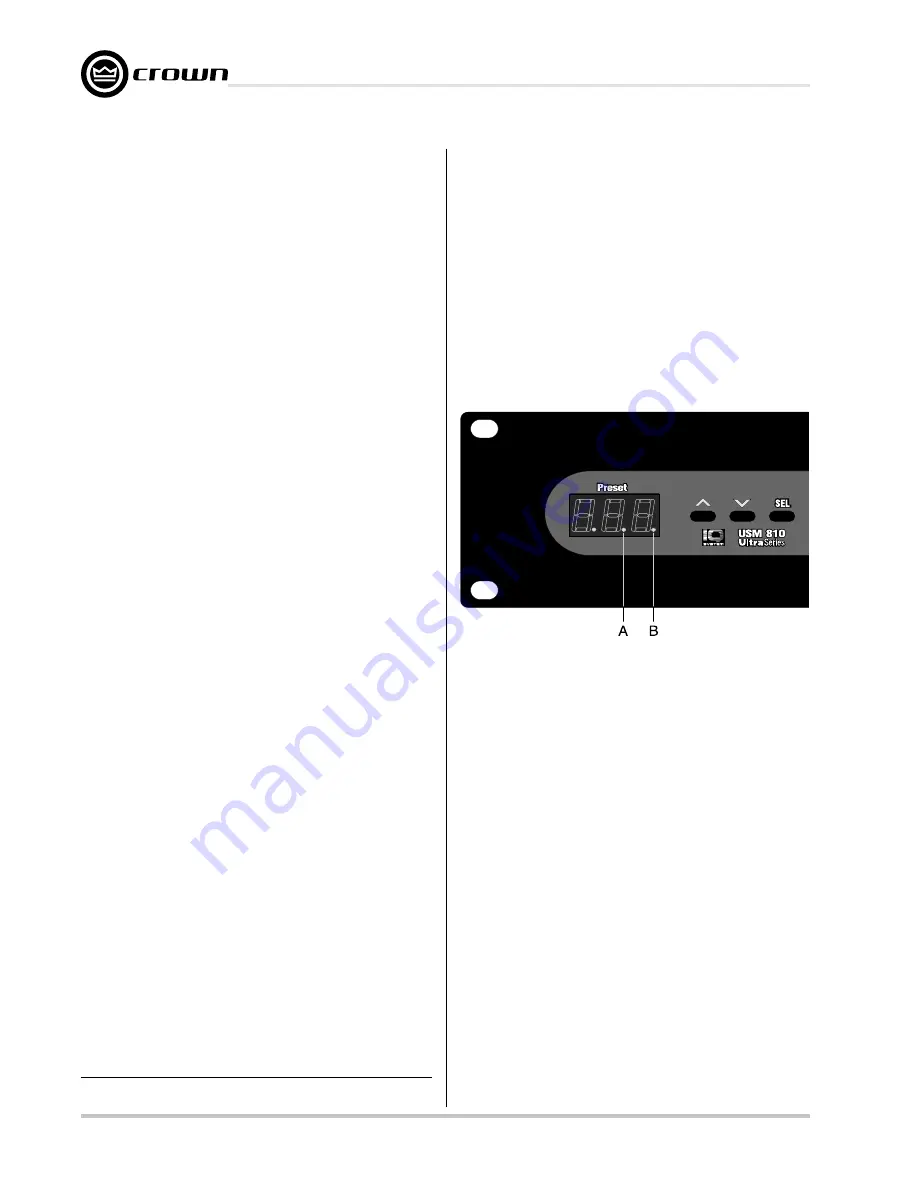
Page 14
IQ-USM 810
IQ Digital Processor / Digital Mixer
IQ-USM 810
Reference Manual
4 Operation
The
Crown IQ-USM 810 digital processor/digital
mixer is an IQ component that can be controlled and
monitored from a remote location via an IQ System,
and provides both audio processing and mixing in a
single package. Metering, gain, gating, filtering,
autoleveling, compression/limiting, delay, and
automixing are all available in an 8-IN/ 10-OUT mix
matrix. All inputs have low noise microphone preamps
and switched phantom power. The unit can be con-
trolled using IQ for Windows either directly from a
computer or as an IQ component on an IQ Bus. The
Multi-Function Control Port allows external control or
monitoring of functions within the box. An internal Real
Time Clock allows full functional presets to be sched-
uled and implemented without any external control.
The following sections describe the IQ-USM 810’s
features and their operation. Where specified, some
features are accessed via controls located on the
unit itself; however, most of the features are config-
ured and controlled using IQ for Windows software.
If you are unfamiliar with IQ for Windows software,
please refer to the IQ for Windows Help files, visit the
Crown Audio website, or contact your Crown repre-
sentative or the Crown Technical Support Group (see
Section 7 for contact information).
4.1 Hardware Features
4.1.1 Selector Buttons
Three front panel buttons (Figure 4.1) are provided to
select presets and to change address and baud
rate. The SEL button, when pressed and held for
longer than 2 seconds, causes the display to cycle
through the available choices until it is released; first
to address select mode, then to baud rate select
mode, then back to preset select mode. Once the
SEL button is released, the up and down arrow but-
tons are used to adjust each parameter. When the
SEL button is released, the user has two seconds to
begin using the up or down arrow buttons before the
display changes back to default. When the param-
eter is adjusted to the desired value, press the SEL
button again to store the setting. See Section 3.1 for
information about selecting IQ address and baud
rate. Front panel control may be locked out via IQ for
Windows software.*
4.1.2 Digital Display
The three-segment digital display (Figure 4.1) serves
several useful functions. When power is first applied, it
displays an initialization sequence. Once the unit is
initialized, the display changes to Preset Mode, indi-
cating the presently selected preset. The display also
indicates the IQ address and baud rate when those
parameters are being adjusted. When a parameter is
changed, a small indicator (letter A in Figure 4.1) mo-
mentarily lights to show the parameter has been stored
in FLASH memory. Another small indicator (letter B in
Figure 4.1) is lit whenever any parameter is varied from
its value within the currently selected preset.
* When front panel controls are locked out, the digital display reads "Lxx"
rather than the usual "Pxx" to indicate the locked status of the controls.
See Section 2 for locations of the following hard-
ware features and controls.
4.1.3 Enable Indicator
A blue front panel Enable indicator lights to show
that AC power is being supplied.
4.1.4 DATA Indicator
An amber front panel Data Signal Presence Indi-
cator (DATA) flashes whenever commands ad-
dressed to the IQ-USM 810 are received. To assist
with troubleshooting, an option that forces the
DATA indicator to remain lit is available through IQ
for Windows software.
4.1.5 Interface Indicator
A green front panel Interface indicator lights when
the IQ-USM 810 is being used as a system interface.
The control to set the IQ-USM 810 as an interface is
available through IQ for Windows software, allowing
only one interface per system.
Figure 4.1 Selector Buttons and Digital Display















































